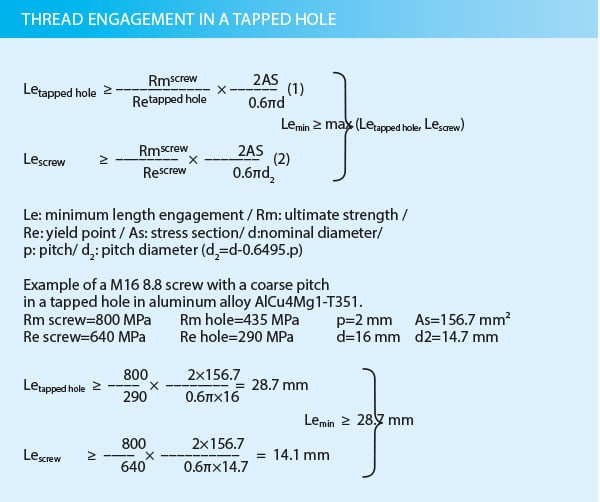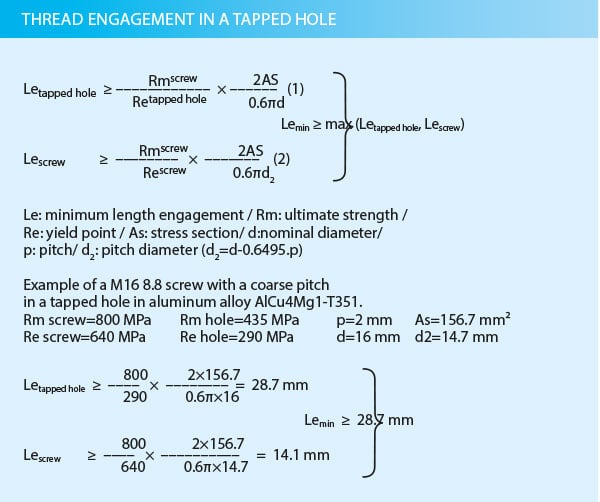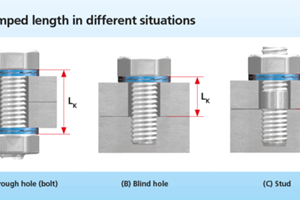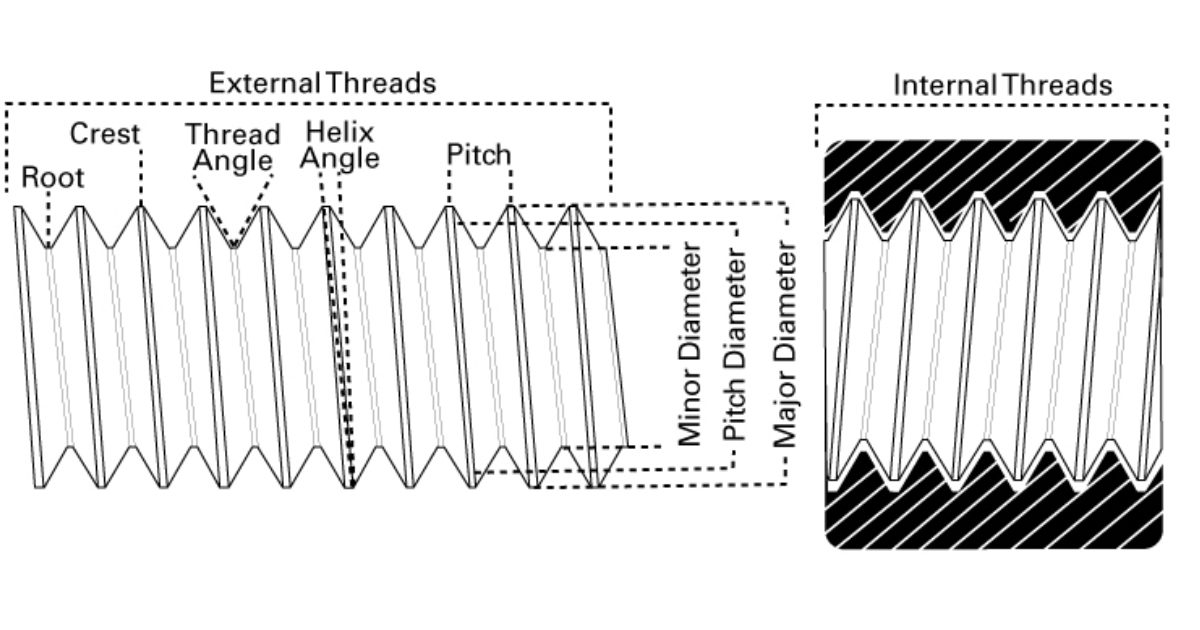Fastener Thread Engagement Ratio Design Calculator

The Fastener Thread Engagement Ratio Design Calculator is a valuable tool for engineers and designers to determine the optimal thread engagement length for their applications. This calculator helps to ensure that the threaded fasteners provide sufficient strength and durability to withstand various loads and stresses. By inputting key parameters such as thread diameter, material properties, and load conditions, users can quickly calculate the required thread engagement ratio to meet their design requirements, saving time and improving the overall performance of their designs. This calculator is particularly useful for critical applications.
- Fastener Thread Engagement Ratio Design Calculator: A Comprehensive Guide
- How do you calculate thread engagement of a fastener?
- What is the rule of thumb for thread engagement?
- What is the 3 thread rule?
- How much thread engagement should I have?
-
Frequently Asked Questions (FAQs)
- What is the purpose of the Fastener Thread Engagement Ratio Design Calculator?
- How does the Fastener Thread Engagement Ratio Design Calculator work?
- What are the benefits of using the Fastener Thread Engagement Ratio Design Calculator?
- What types of fasteners can be used with the Fastener Thread Engagement Ratio Design Calculator?
Fastener Thread Engagement Ratio Design Calculator: A Comprehensive Guide
The Fastener Thread Engagement Ratio Design Calculator is a tool used to determine the minimum thread engagement length required for a bolt or screw to achieve a safe and reliable connection. This calculator takes into account various factors such as the type of material, the diameter of the bolt, and the desired safety factor. The result is a calculation of the minimum thread engagement length required to prevent thread stripping or pull-out.
Introduction to Fastener Thread Engagement Ratio
The Fastener Thread Engagement Ratio is a critical parameter in the design of bolted connections. It is defined as the ratio of the thread engagement length to the diameter of the bolt. A higher engagement ratio indicates a stronger connection, while a lower ratio may lead to thread stripping or pull-out. The calculator uses mathematical models and empirical formulas to determine the optimal engagement ratio for a given application.
Key Factors Affecting Thread Engagement Ratio
Several factors affect the thread engagement ratio, including the material properties, bolt diameter, and desired safety factor. The calculator takes into account these factors to provide an accurate calculation of the minimum thread engagement length required. For example, a higher strength material may require a lower engagement ratio, while a larger bolt diameter may require a higher engagement ratio.
Benefits of Using a Fastener Thread Engagement Ratio Design Calculator
Using a Fastener Thread Engagement Ratio Design Calculator offers several benefits, including improved safety, reduced risk of failure, and increased efficiency. The calculator helps designers and engineers to quickly and accurately determine the minimum thread engagement length required, reducing the risk of thread stripping or pull-out. This can lead to cost savings and reduced downtime.
Limitations and Assumptions of the Calculator
The Fastener Thread Engagement Ratio Design Calculator is based on simplifying assumptions and mathematical models. It assumes a perfect thread form and uniform material properties. In reality, thread forms may be imperfect, and material properties may vary. Therefore, the calculator should be used in conjunction with experimental testing and expert judgment to ensure a safe and reliable connection.
Applications of the Fastener Thread Engagement Ratio Design Calculator
The Fastener Thread Engagement Ratio Design Calculator has a wide range of applications, including aerospace engineering, automotive engineering, and construction engineering. It can be used to design bolted connections in aircraft, vehicles, and buildings. The calculator can also be used to optimize existing designs and troubleshoot failed connections.
| Factor | Unit | Description |
|---|---|---|
| Material Properties | - | Ultimate tensile strength, yield strength, and elongation |
| Bolt Diameter | mm | Diameter of the bolt |
| Desired Safety Factor | - | Factor of safety to account for uncertainties and variations |
How do you calculate thread engagement of a fastener?

To calculate thread engagement of a fastener, you need to consider the thread length, thread pitch, and material strength. Thread engagement refers to the length of thread that is engaged between the fastener and the material it is being screwed into. This is an important factor in determining the strength and stability of the connection. The calculation involves measuring the thread length and pitch, and then using a formula to determine the minimum thread engagement required for a safe and secure connection.
Understanding Thread Engagement
Thread engagement is a critical factor in fastener design, as it affects the load-carrying capacity of the connection. To calculate thread engagement, you need to understand the thread geometry and the material properties. The thread engagement calculation involves the following steps:
- Measure the thread length and thread pitch of the fastener
- Determine the material strength and yield strength of the material being screwed into
- Use a formula to calculate the minimum thread engagement required for a safe and secure connection
This calculation helps ensure that the fastener is properly secured and can withstand the expected loads and stresses.
Factors Affecting Thread Engagement
Several factors can affect thread engagement, including thread pitch, thread length, and material strength. The thread pitch affects the thread engagement by determining the number of threads that are engaged. A finer thread pitch will result in more threads being engaged, which can increase the strength of the connection. The thread length also affects the thread engagement, as a longer thread will provide more engagement and a stronger connection. The material strength is also an important factor, as a stronger material will require more thread engagement to ensure a safe and secure connection.
- Thread pitch affects the number of threads engaged
- Thread length affects the amount of engagement
- Material strength affects the required thread engagement
Calculating Thread Engagement
To calculate thread engagement, you can use a formula that takes into account the thread length, thread pitch, and material strength. The formula will provide the minimum thread engagement required for a safe and secure connection. The calculation involves measuring the thread length and thread pitch, and then using a formula to determine the minimum thread engagement. The formula may include factors such as thread friction, material elasticity, and load-carrying capacity.
- Measure the thread length and thread pitch
- Use a formula to calculate the minimum thread engagement
- Consider additional factors such as thread friction and material elasticity
Thread Engagement in Different Materials
Thread engagement can vary depending on the material being screwed into. Different materials have different strengths and properties, which affect the thread engagement. For example, aluminum and steel have different strengths and elasticities, which require different thread engagements. The calculation of thread engagement must take into account the material properties to ensure a safe and secure connection.
- Aluminum requires a different thread engagement than steel
- Material strength affects the required thread engagement
- Material elasticity affects the thread engagement calculation
Importance of Thread Engagement in Fastener Design
Thread engagement is a critical factor in fastener design, as it affects the strength and stability of the connection. Proper thread engagement ensures that the fastener is properly secured and can withstand the expected loads and stresses. The calculation of thread engagement helps ensure that the fastener is designed to provide a safe and secure connection.
- Thread engagement affects the strength of the connection
- Fastener design must consider thread engagement
- Proper thread engagement ensures a safe and secure connection
What is the rule of thumb for thread engagement?

The rule of thumb for thread engagement is to ensure that the threads are fully engaged to achieve the desired level of security and reliability in the assembly. This can be achieved by following the manufacturer's recommendations for thread engagement, which is usually specified as a minimum number of threads that must be engaged. The rule of thumb is to engage at least 2.5 to 3 times the diameter of the thread to ensure a safe and reliable assembly.
Understanding Thread Engagement
Thread engagement is critical in ensuring the integrity of the assembly, as it directly affects the strength and stability of the joint. To achieve proper thread engagement, it is essential to understand the thread geometry, including the thread diameter, pitch, and length. The following are key factors to consider:
- The thread diameter must be compatible with the nut or receiving thread to ensure proper engagement.
- The thread pitch must be matched to the application to ensure the desired level of security and reliability.
- The thread length must be sufficient to engage the minimum number of threads required for the application.
Factors Affecting Thread Engagement
Several factors can affect thread engagement, including the material properties, surface finish, and assembly conditions. The coefficient of friction between the threads can also impact the engagement, as it affects the torque required to achieve proper engagement. The following are key factors to consider:
- The material properties, such as hardness and tensile strength, can affect the thread engagement and joint strength.
- The surface finish of the threads can impact the friction and wear of the assembly.
- The assembly conditions, such as temperature and humidity, can affect the thread engagement and joint stability.
Calculating Thread Engagement
Calculating thread engagement involves determining the minimum number of threads required to achieve the desired level of security and reliability. This can be done using thread engagement calculations, which take into account the thread geometry, material properties, and assembly conditions. The following are key factors to consider:
- The thread engagement calculation must consider the thread diameter, pitch, and length.
- The material properties, such as hardness and tensile strength, must be considered in the calculation.
- The assembly conditions, such as temperature and humidity, must be considered in the calculation.
Best Practices for Thread Engagement
Best practices for thread engagement include following the manufacturer's recommendations for thread engagement, using high-quality threads, and ensuring proper assembly conditions. The following are key factors to consider:
- Follow manufacturer's recommendations for thread engagement to ensure security and reliability.
- Use high-quality threads to ensure strength and stability of the assembly.
- Ensure proper assembly conditions, such as cleanliness and dryness, to prevent contamination and corrosion.
Common Mistakes in Thread Engagement
Common mistakes in thread engagement include insufficient thread engagement, incorrect thread geometry, and inadequate assembly conditions. The following are key factors to consider:
- Insufficient thread engagement can lead to premature failure and reduced reliability.
- Incorrect thread geometry can lead to reduced strength and stability of the assembly.
- Inadequate assembly conditions can lead to contamination and corrosion, reducing the life of the assembly.
What is the 3 thread rule?

The 3 thread rule is a guideline used in online communities, particularly on social media platforms and forums, to determine whether a user's post is considered spam or not. This rule states that if a user posts three or more links to the same website or webpage in a short period, it is likely to be considered spam. The purpose of this rule is to prevent users from flooding the community with promotional content and to maintain a healthy and engaging environment for all users.
Understanding the 3 Thread Rule
The 3 thread rule is essential in maintaining the integrity of online communities. When a user posts multiple links to the same website, it can be seen as an attempt to manipulate the community and promote their own interests. To avoid this, users should be aware of the posting guidelines and community rules.
- Read the community guidelines carefully before posting any content.
- Understand the consequences of posting spam content, such as account suspension or banning.
- Respect the community and its members by posting relevant and high-quality content.
Consequences of Breaking the 3 Thread Rule
Breaking the 3 thread rule can have severe consequences for users. If a user is found to be posting spam content, their account may be suspended or banned. This can result in the loss of access to the community and the reputation of the user. To avoid this, users should be cautious when posting links and ensure that they are not overposting.
- Avoid posting multiple links to the same website in a short period.
- Use alternative methods to share content, such as descriptive text or images.
- Engage with the community by responding to comments and messages.
Best Practices for Posting Links
To avoid breaking the 3 thread rule, users should follow best practices when posting links. This includes providing context for the link, using descriptive text, and avoiding overposting. By following these guidelines, users can ensure that their posts are well-received by the community.
- Provide context for the link, such as a brief description or summary.
- Use descriptive text to explain the content of the link.
- Avoid posting multiple links in a single post.
Community Guidelines and Rules
Each online community has its own set of guidelines and rules. These guidelines outline the expected behavior of users and the consequences of breaking the rules. Users should familiarize themselves with these guidelines to avoid accidentally breaking the 3 thread rule.
- Read the community guidelines carefully before posting any content.
- Understand the consequences of breaking the rules, such as account suspension or banning.
- Respect the community and its members by posting relevant and high-quality content.
Managing Spam Content
Managing spam content is crucial in maintaining the health of online communities. This includes monitoring user posts, detecting spam content, and removing it from the community. By effectively managing spam content, communities can ensure that users have a positive and engaging experience.
- Use moderation tools to monitor user posts and detect spam content.
- Remove spam content from the community to prevent flooding.
- Encourage users to report spam content to help maintain the community.
How much thread engagement should I have?

The amount of thread engagement you should have depends on various factors, including the platform, content type, and target audience. Generally, a higher engagement rate is considered better, but it's essential to understand that engagement metrics can vary greatly depending on the context. For instance, a thread on a social media platform like Twitter may require a different level of engagement compared to a forum or a blog comment section.
Understanding Thread Engagement Metrics
Thread engagement metrics are used to measure the performance of a thread, and they can include likes, comments, shares, and replies. To determine the ideal amount of thread! engagement, you need to consider the following factors:
- The type of content being discussed, as some topics may naturally generate more engagement than others
- The size and activity of the community or audience, as a larger and more active community may lead to higher engagement rates
- The format and structure of the thread, as a well-organized and easy-to-follow thread may encourage more participation
Setting Realistic Thread Engagement Goals
Setting realistic goals for thread engagement is crucial to evaluating its success. When setting goals, consider the average engagement rate of similar threads in your niche or industry. You should also take into account the resources and effort you are willing to invest in promoting the thread and encouraging engagement. Some key factors to consider when setting goals include:
- The relevance and interest of the topic, as a more interesting and relevant topic may generate more engagement
- The quality and frequency of posts and updates, as regular and high-quality content may keep the audience engaged
- The level of interaction and response from the community, as a more interactive and responsive community may lead to higher engagement rates
Measuring and Analyzing Thread Engagement
Measuring and analyzing thread engagement is essential to understanding its effectiveness and identifying areas for improvement. You can use analytics tools to track engagement metrics and gain insights into the behavior and preferences of your audience. Some key metrics to measure and analyze include:
- The number of comments and replies, as a higher number may indicate a more engaging thread
- The quality and relevance of comments and replies, as high-quality and relevant comments may indicate a more interested and invested audience
- The engagement rate and participation of influencers or key community members, as their participation may influence the overall engagement rate
Encouraging and Increasing Thread Engagement
Encouraging and increasing thread engagement requires a strategic approach that considers the needs and preferences of your audience. You can use various tactics to stimulate engagement, such as asking questions, requesting feedback, and recognizing and rewarding contributors. Some key strategies to consider include:
- Creating a sense of community and belonging, as a strong sense of community may encourage more engagement and participation
- Providing value and insights through high-quality content, as valuable and insightful content may attract and retain a larger audience
- Using visuals and multimedia to make the thread more engaging and interactive, as visuals and multimedia may capture the audience's attention and encourage participation
Optimizing Thread Engagement for Better Outcomes
Optimizing thread engagement for better outcomes requires a data-driven approach that takes into account the strengths and weaknesses of your content and audience. You can use A/B testing and experimentation to identify the most effective strategies and tactics for increasing engagement. Some key factors to consider when optimizing thread engagement include:
- The timing and frequency of posts and updates, as optimal timing and frequency may influence the engagement rate
- The length and format of the thread, as a well-structured and easy-to-follow thread may encourage more participation
- The level of personalization and relevance, as a more personalized and relevant thread may attract and retain a larger audience
Frequently Asked Questions (FAQs)
What is the purpose of the Fastener Thread Engagement Ratio Design Calculator?
The Fastener Thread Engagement Ratio Design Calculator is a tool used to determine the optimal thread engagement for a given fastener and material combination. This calculator takes into account various factors such as the fastener diameter, thread pitch, material strength, and desired safety factor to calculate the required thread engagement length. The purpose of this calculator is to ensure that the fastener is properly secured to prevent loosening or failure due to insufficient thread engagement. By using this calculator, designers and engineers can optimize their designs and ensure that their fasteners meet the required safety standards. The calculator is particularly useful in high-stress applications where fastener failure could have serious consequences.
How does the Fastener Thread Engagement Ratio Design Calculator work?
The Fastener Thread Engagement Ratio Design Calculator uses a complex algorithm to calculate the thread engagement ratio based on the input parameters. The calculator first determines the minimum thread engagement length required to achieve the desired safety factor, taking into account the material strength, fastener diameter, and thread pitch. The calculator then uses this value to calculate the thread engagement ratio, which is expressed as a percentage of the fastener diameter. The calculator also provides recommendations for the minimum thread engagement length and the maximum allowable torque to ensure that the fastener is properly secured. The calculator is based on industry standards and best practices, and is regularly updated to reflect the latest research and developments in the field of fastener design.
What are the benefits of using the Fastener Thread Engagement Ratio Design Calculator?
The benefits of using the Fastener Thread Engagement Ratio Design Calculator are numerous. One of the main benefits is that it helps to ensure safety by preventing fastener failure due to insufficient thread engagement. The calculator also helps to optimize designs by determining the minimum thread engagement length required to achieve the desired safety factor, which can help to reduce material costs and improve efficiency. Additionally, the calculator provides valuable insights into the behaviour of fasteners and materials, allowing designers and engineers to make informed decisions about their designs. The calculator is also easy to use and quick to provide results, making it a valuable tool for anyone involved in fastener design or engineering. By using the calculator, users can save time and reduce the risk of fastener failure, which can have serious consequences in high-stress applications.
What types of fasteners can be used with the Fastener Thread Engagement Ratio Design Calculator?
The Fastener Thread Engagement Ratio Design Calculator can be used with a wide range of fasteners, including bolts, screws, studs, and nuts. The calculator is particularly useful for high-strength fasteners such as Grade 8 or Grade 10 bolts, which are commonly used in high-stress applications. The calculator can also be used with specialized fasteners such as aerospaced fasteners or medical fasteners, which require high levels of precision and reliability. Additionally, the calculator can be used with fasteners made from a variety of materials, including steel, aluminum, and titanium. The calculator is flexible and can be customized to meet the specific needs of the user, making it a valuable tool for anyone involved in fastener design or engineering. By using the calculator, users can ensure that their fasteners are properly designed and optimized for their specific application.
Deja una respuesta

Entradas Relacionadas